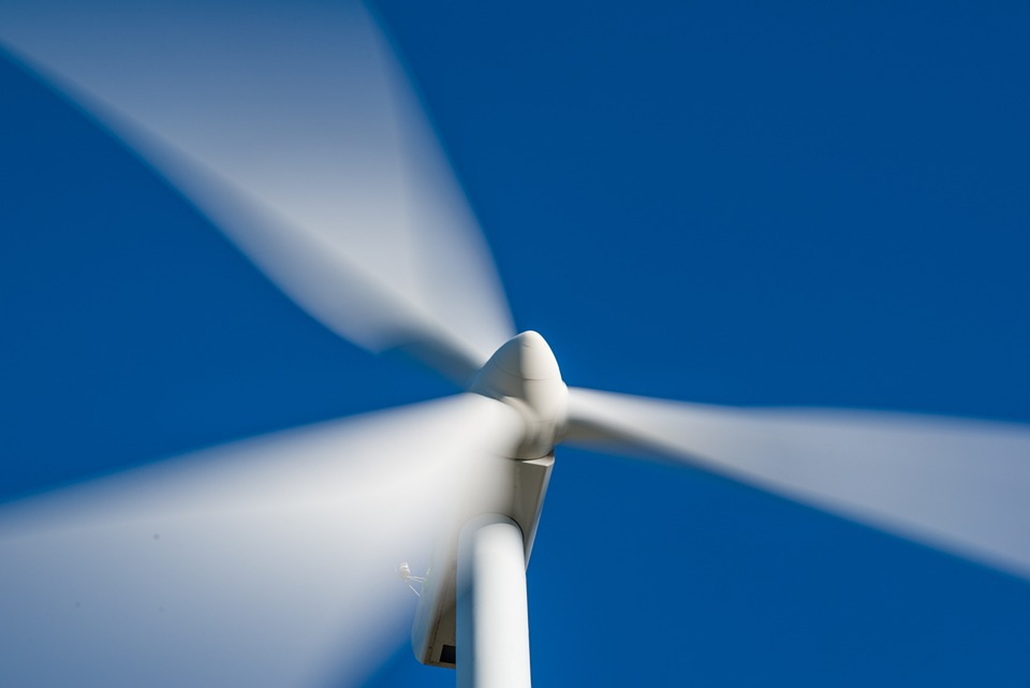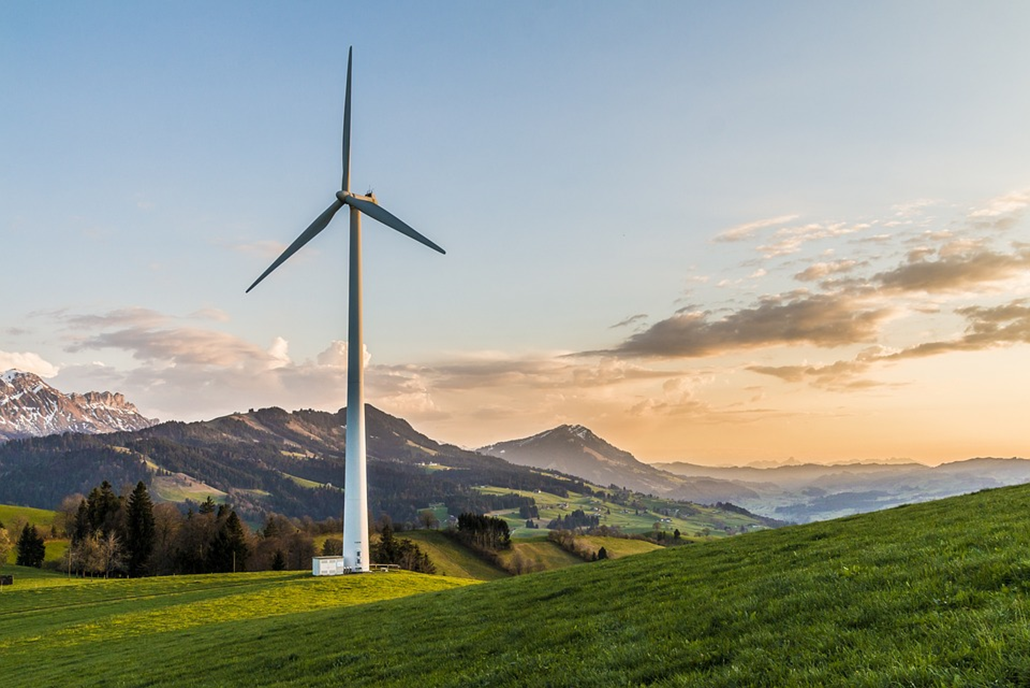Wind turbines are massive structures that we utilize to generate electrical power. Harnessing the power of the wind, these towering giants turn blades to create renewable energy that powers homes and businesses.
But how fast do wind turbines spin? Does speed matter? Or is it more about power?
There's more to the story than just how fast our modern-day giants can spin. There is also a science behind understanding their speed.
Let's learn more about the inner workings of a wind turbine. Discover how exactly maximum wind turbine speeds function and how technicians and scientists calculate its speed.

Wind energy is a process where kinetic energy from the atmosphere is converted into clean, sustainable energy. Specially designed wind turbines convert air flow into electricity using wind energy.
After that, the electricity is distributed to residences and commercial establishments via a grid system.
You can typically find wind turbines in large open areas like rural landscapes or offshore wind farms.
The turbine's size and its blades' revolutions per minute are determining factors in how much energy it can produce.
Wind turbines are large structures that generate electrical power by harnessing the wind. These gigantic pinwheels typically consist of three blades attached to a tower.
The rotating turbine blades harness the wind power, generating electricity, which in turn causes an internal generator to rotate and deliver electrical power.
This energy is then usually transferred to a power grid, where it's then distributed to homes and places of business.
From larger blades to different rotations per minute, here are some of the most common types of wind turbines.
Horizontal Axis Wind Turbines, or HAWT for short, consist of three blades attached to a tower or nacelle with a horizontal rotation axis. When the blades are exposed to wind, they spin, which causes a generator housed inside to rotate and produce energy.
Depending on the application, HAWTs typically range from 10 feet to over 400 feet tall.
Vertical Axis Wind Turbines (VAWTs) consist of four or more blades attached to a tower and have a vertical axis of rotation.
Like above, once they are exposed to wind, they begin to rotate, which in turn causes an internal generator to turn and generate energy.
VAWTs usually range in size from 10 feet to over 200 feet tall. However, once again, the size depends on the application.
Offshore wind farms are extensive collections of turbines located at sea or in other deep water areas. These wind farms can generate enormous energy because they take advantage of the wind direction and more consistent offshore winds.
Looking out across the horizon, you probably have seen an offshore wind farm. These wind farms have larger turbines than those found onshore and can generate more power.
The China State Shipbuilding Company (CSSC) recently announced the largest wind turbine ever constructed. This offshore behemoth will have a maximum output of 18 megawatts.
How fast a wind turbine spins comes down to several factors.
These can include wind conditions, the wind turbine design, the blade tip speed, and even the difference in air pressure around the turbine. In general, the speeds at which turbines can function can range anywhere from 6 to 55 mph.
In commercial use, you can expect the survival speed of wind turbines to be approximately 70 meters per second. But some models can go up to 80 meters per second.

Wind turbine technicians must factor in the blade tip speed, air pressure, and a number of other factors when calculating the speed of a turbine.
The blade tip speed of a wind turbine influences its energy production. An increased blade tip speed leads to higher energy output.
Wind turbines also have an optimal survival speed, determined by their design and how much energy they can produce efficiently. If the wind speeds exceed this survival speed, the blades may break or become damaged.
A few factors can affect the rotation speed of a wind turbine. For example, the size and shape of the blades, strong winds, and sometimes the surrounding terrain can all affect wind turbine speed.
In addition to the aforementioned environmental circumstances, mechanical factors can influence a turbine's maximum speed.
The turbine gearbox is the most common mechanical factor. Technicians can adjust the turbine's constant speed, either increasing or decreasing it. They can also adjust the blades' angle of attack to optimize performance.
These factors also show you how important the role of a wind turbine technician is in regulating the speed of wind turbine rotation.
Wind turbines generate electricity by rotating turbine blades, which connect to an internal generator. The blades will spin faster if the wind speed is higher. Thus, the turbine generates more electricity.
The turbine blades constantly move through the air regardless of wind loads, thereby absorbing kinetic energy, which is subsequently transferred to a generator, where the conversion to electrical power happens.
As soon as the winds hit, the turbine begins to produce energy. Even a slight breeze can still rotate the turbine, so there's no concern for wind turbines that don't spin at maximum speed. The turbines will still deliver electricity, although not at optimum levels.

The technology behind the speeds of a wind turbine involves several components working in tandem.
In addition to the rotor, other technologies help optimize performance and increase efficiency.
The process by which a turbine transforms kinetic energy into mechanical energy is known as kinetic energy and mechanical energy conversion. The blades capture kinetic energy as they rotate, which subsequently drives a generator to produce electrical power.
This process relies on the interaction between air and the rotor blades to generate power. Increased wind speed allows more air to pass over the blades, propelling them to spin more rapidly. And that's how the turbines generate more electricity on the grid.
The most prevalent kind of wind turbine blades are propellers, which offer a lot of lift to accelerate spinning.
The giant blades of wind turbines are aerodynamically engineered, allowing a wind turbine to make the most of the wind's energy for increased power output.
Rotating blades are designed to be more efficient than propeller blades by optimizing the shape of the blade. The shape is designed to capture more wind energy, increasing rotation speed and efficiency.
The tower's structural design is one of the critical aspects of getting the most efficient power output from a wind turbine.
Taller towers can access stronger winds at higher altitudes, generating more energy. Additionally, towers should also be designed to minimize turbulence and swaying, which can reduce the efficiency of a turbine.
Magnetic fields are used in wind turbines to help increase the efficiency of energy production. These fields interact with the turbine's rotors, creating a stronger magnetic field that helps optimize performance.
Turbulent flow is another key factor to consider in how and why the speed of a wind turbine can rise. This flow occurs when turbulent air passes over the blades of a turbine, causing an increase in speed.
A natural occurrence, this can then be harnessed to improve the overall performance of wind turbines, making the whole process more effective and efficient in energy generation.
The turbulent flow increases the speed of the turbine and wind turbine blade velocity, which can also increase the efficiency of energy production. Turbulence also helps reduce noise and vibration, making turbines more efficient and less intrusive.

It's essential to control the speed to ensure the optimal performance of wind turbines.
Technicians use several methods to monitor wind turbine performance and speed control, including pitch regulation, variable-speed technology, and blade design optimization.
Wind turbine pitch regulation is a method used to limit the rotational speed of a turbine by adjusting the blade pitch angle.
Carrying out this adjustment involves using an automated system that adjusts the blades in response to changing wind speed and direction, controlling how much energy the blades can extract.
Variable-speed technology is a method used to control the rotational speed of a turbine by adjusting the wind turbine generator speed and motor speed.
This technology allows turbines to operate at various speeds, optimizing their efficiency. Plus, it reduces noise levels.
The design of the blade can play a significant role in how efficiently a turbine can harness the wind. This technique is known as the optimization of a turbine's blade design.
Optimized design can help capture more wind energy, increasing rotational speeds and efficiency.
Power regulation is a method used to ensure that wind turbines generate an optimal amount of power. This method is accomplished by monitoring the turbine's voltage and frequency output and adjusting it per those readings.
It helps ensure that the turbine produces enough energy while avoiding any potential damage due to excessive power levels.
Understanding how to accurately measure and calculate the speed of a modern wind turbine is an essential aspect of evaluating that machine's overall performance. Several methods are used to accurately measure and calculate the speeds of a wind turbine, including anemometry, laser Doppler vibrometry (LDV), and flow visualization.
Anemometry measures the speed of air moving around a turbine by using a device that measures changes in air pressure.
Laser Doppler vibrometry (LDV) is a method used to measure the speed of the blades of a wind turbine. LDV uses lasers to measure vibrations and calculate the rotational speed of the blades.
Flow visualization is a method used to analyze and visualize the flow patterns around a turbine to understand its performance better. This method uses high-speed cameras to capture the movement of air around a turbine and analyze it.
To round it up, the science behind wind turbine speeds is an exciting field of research. The future looks to be greener for us all.
Wind energy is an excellent energy source since it is clean, renewable, and efficient. And wind turbines are critical to wind energy production. Moreover, their performance constantly improves with technological advancements and research.
A career in wind energy may be an exciting career path for those carrying a healthy interest in wind turbine mechanics. The Pinnacle Career Institute can be your starting point for a prosperous future.
Our institute will prepare you for a wind turbine or tower technician job. You will be well on your way to a successful profession more rapidly if you enroll in one of our fast-paced trade school programs.
Learn more about the services offered by PCI and get started today.
About PCI
We believe education has the power to change our lives, our community, and our future.
Address: 11500 N Ambassador Dr Suite 221, Kansas City, MO 64153
Phone Number: (800) 676-7912
Useful Links
News & Updates